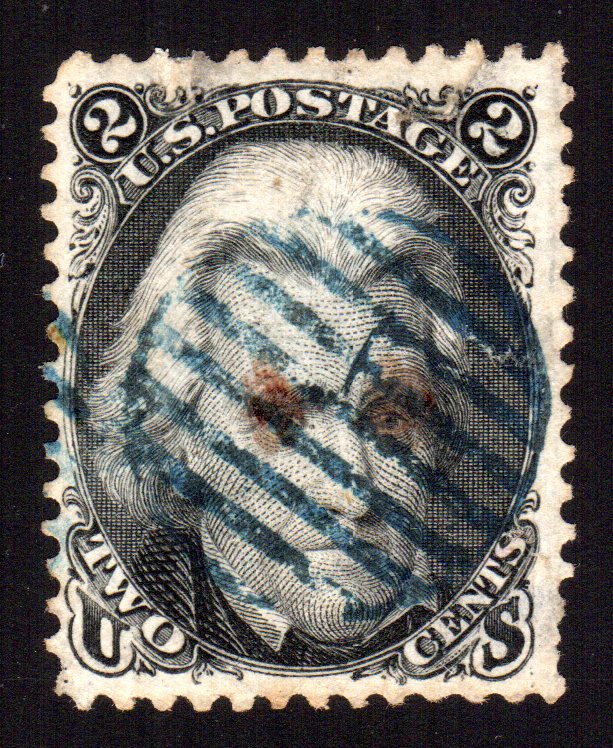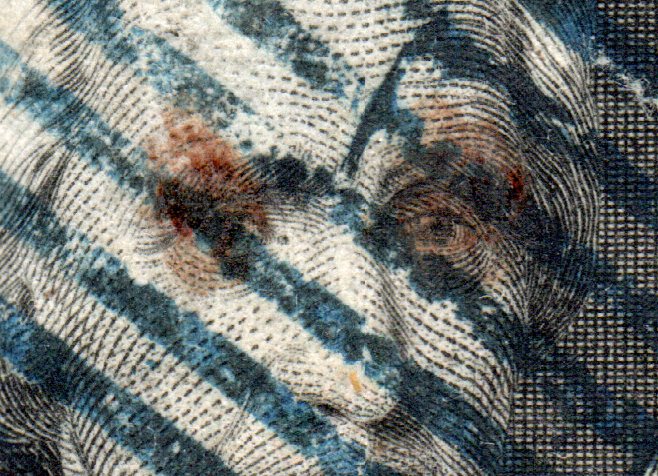de61
Member 
Posts: 262
|
Post by de61 on Feb 16, 2022 19:09:11 GMT
Shown is a Scott #73 Andrew Jackson stamp from sometime between 1863 and 1866. Whoever used the stamp on the mail stained the eyes with red ink. The staining looks like small "X"s and lies under the blue grid cancel. Does anyone know the significance of the eye stains and why it was done? My best guess is it is related to the temperance movement. Jackson was known as a heavy drinker, but supported the temperance movement as he got older. He co-signed a statement (circa 1833) along with James Madison and John Quincy Adams urging Americans, especially young men, to refrain from drinking alcohol. My other guess relates to a story regarding Jackson admonishing his cook for having bloodshot eyes from drinking the night before. Jackson, then a general in the army, told the cook to bring him some country ham with gravy "as red as his eyes." Other soldiers heard the comment and started calling ham gravy "red eye gravy." Any information, even speculation, is welcome.   |
|
banknoteguy
Member 
Posts: 324
What I collect: 19th Century US, High denomination US (> $1), 19th century covers US, Indian Feudatory States and most recently I acquired a BigBlue [with about 5,000 stamps] and pristine pages.
|
Post by banknoteguy on Feb 16, 2022 19:36:57 GMT
I have no additional info but I like your second hypothesis! Red-eye gravy indeed. Also a very nicely centered example. This variety is notorious for no margins or perfs cut into the stamps. You have three large margins and one OK margin. Nice. Plus the red-eyes and blue cancel.
|
|
dorincard
Member 
Posts: 1,623  What I collect: My focus is on Wild Mammals on maximum cards. Occasionally, I get or create maximum cards with other animals, or any other topic.
What I collect: My focus is on Wild Mammals on maximum cards. Occasionally, I get or create maximum cards with other animals, or any other topic.
|
Post by dorincard on Feb 16, 2022 21:41:41 GMT
Many personalities on stamps have..."historical legacy stains". Figuratively, not on their figure.
Go figure.
|
|
Beryllium Guy
Moderator 
Posts: 5,912  What I collect: Worldwide Stamps 1840-1930
What I collect: Worldwide Stamps 1840-1930
|
Post by Beryllium Guy on Feb 16, 2022 22:14:14 GMT
When I see the US classic "Black Jack" with those red eyes, it reminds me irrepressibly of The Joker in the Batman comic series, especially the Jack Nicholson portrayal.... Sorry, but I couldn't resist!   Coming back to the stamp itself, de61, I am totally impressed by your research in this area, and I think that either one of your hypotheses could make sense. Great work! |
|
kasvik
Member 
Posts: 607
What I collect: Cancels mostly, especially Sweden Gävle and Lidingö, Switzerland Geneva, Germany Pforzheim
|
Post by kasvik on Feb 19, 2022 4:09:20 GMT
Shown is a Scott #73 Andrew Jackson stamp from sometime between 1863 and 1866. Whoever used the stamp on the mail stained the eyes with red ink. The staining looks like small "X"s and lies under the blue grid cancel. Does anyone know the significance of the eye stains and why it was done? My best guess is it is related to the temperance movement. Jackson was known as a heavy drinker, but supported the temperance movement as he got older. He co-signed a statement (circa 1833) along with James Madison and John Quincy Adams urging Americans, especially young men, to refrain from drinking alcohol. My other guess relates to a story regarding Jackson admonishing his cook for having bloodshot eyes from drinking the night before. Jackson, then a general in the army, told the cook to bring him some country ham with gravy "as red as his eyes." Other soldiers heard the comment and started calling ham gravy "red eye gravy." Any information, even speculation, is welcome.
That explanation certainly is possible. But maybe you're trying too hard. Jackson was controversial all his life, even as a boy. Putting him on stamp was a Civil War effort to placate border states by identifying the Union with a Southern hero. Anyone active in abolitionist politics, or with the Republican/Whig party, would have been horrified. The monstrously over-sized portrait made the sight all the worse.
We're still fighting about this, as in the controversy over replacing him on the US Twenty Dollar Bill.
|
|